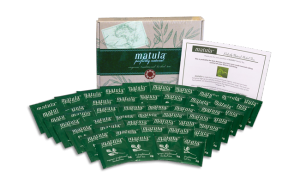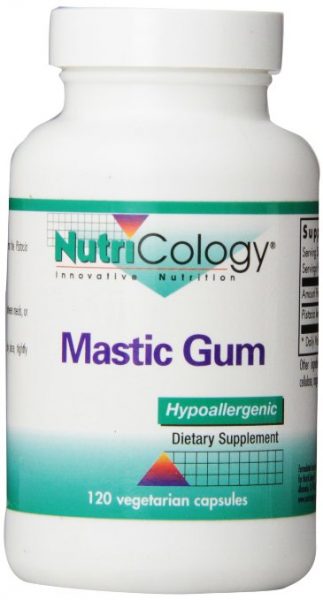
In the natural health world, there are a lot of remedies which come and go quickly. It is nearly impossible to keep up with all of these trends. Yet, some of these natural remedies stay in the spotlight – and for good reason: they actually work. This is the case with mastic gum, a tree resin from Greece which is proven to help fight h. pylori infections, ulcers, candida, and much more.
What is Mastic Gum?
Mastic gum is a resin which comes from pistacia lentiscus, which is an evergreen tree belonging to the pistachio family. When the mastic tree is scored, the resin starts to flow out of it forming “teardrops.” The drops solidify when they hit the air. After about 15 to 30 days the mastic resin becomes totally crystallized.1
Once the resin has crystallized, it can be chewed as a gum. In fact, the word masticate comes from the Greek word mastikhan meaning “to grind the teeth.” When you first start chewing the mastic gum resin, it has a bitter taste (which admittedly can take some getting used to). After chewing for a while, the bitterness goes away and you have only an aroma.2, 3
Alternatively, mastic gum can be ground into a powder then used in culinary dishes. It helps to freeze the mastic beforehand to make it easier to grind with a mortar and pestle.4

Mastic Gum in History
The use of mastic gum goes back centuries. Greeks traditionally use mastic in many culinary dishes ranging from savory sauces to desserts. Mastic is also a key ingredient in the liquor called mastika or mastiha.
The Greeks have also known about the medicinal of mastic gum for centuries. Pedanios Dioscorides, the “Patron Saint of Herbal Medicine” wrote about mastic in a book called De Materia Medica in 70 AD.
Dioscorides noted many benefits of mastic gum, including that it helped treat internal bleeding (aka ulcer), is a diuretic, strengthens teeth, and fights coughs. His observations are now being confirmed by research.
There is actually a cool legend around mastic gum. When St. Isidore was tortured by the Romans, he was left bleeding under a mastic tree. The trees sympathized with Isidore and started to cry. Their teardrops are mastic gum.
However, others say that the secret to mastic gum is the underwater volcanoes of Chios. These volcanoes produce the conditions which allow the mastic trees to “bleed” their resin.6
Chios Mastic versus Arabic Mastic
The mastic gum tree was long thought to only grow in the Greek island of Chios (hence the name Chios mastic gum). However, the mastic tree has been cultivated in many areas around the Mediterranean.7
Yet, the Chios mastic gum is considered different than the ones grown in other areas: only the Chios mastic trees “bleed” resin when cut. Thus, the EU has granted Chios mastic protected designation of origin (PDO) and protected geographical indication (PGI).8 This is the same labeling system which is used with products like Champagne and similar to the appellation system which used with wines.
Why is mastic gum sometimes called Arabic gum if it is grown in Chios? The reason is because researchers in the Arabic world were the first in modern times to re-discover the health benefits of mastic.
It was during the 1980s that researchers in Iraq (yes, Iraq used to be a highly-developed country!) discovered that mastic gum has anti-ulcer properties and people in the Middle East started using it. As use of mastic gum started to spread, people referred to it as “Arabic gum.” It is also sometimes called “Yemen gum.”9
Note that mastic gum should not be confused with gum Arabic, which is resin from the acacia tree. This is a substitute and will NOT provide the same benefits as true Chios mastic!

Mastic Gum for H. Pylori (Ulcers)
Ancient Greek medicinal literature – including works from Hippocrates and Dioscorides — mentions the stomach-healing benefits of mastic. However, it wasn’t until the 1980s that modern researchers nook notice of mastic gum.
Coincidentally, the 1980s is when researchers realized the true cause of ulcers is a bacteria called helicobacter pylori.
H. pylori causes 80% of ulcers in the stomach and 90% of ulcers in the duodenum. Considering that h. pylori is found in 2/3 of the world’s population, this is something we should really worry about! To make matters worse, h. pylori is also linked to stomach cancer.
H. pylori normally is asymptomatic, so the only reliable way to know if you have it is to get tested. Normally your doctor needs to order the test for you. However, True Health Labs offers a test you can take at home. You can order the h. pylori test here.
If your test shows positive for h. pylori, the good news is that mastic gum can kill h. pylori. Some of the studies which show this include:
- 1998 study published in The New England Journal of Medicine found that even small dosages of mastic gum of 1 mg per day over a course of 2 weeks kills h. pylori. (Source)
- 2007 study published in Antimicrobial Agents and Chemotherapy found that mastic reduced the h. pylori levels in mice by 30-fold (Source)
- 2010 study published in the journal Phytomedicine showed that administering mastic gum in patients in dosages of 1.05 grams per day eradicated h. pylori in over 1/3 of patients. (Source)
Considering how effective mastic gum is at killing h. pylori, it is something that should definitely be considered as an alternative to antibiotics for ulcers. While antibiotics can kill h. pylori, there are numerous side effects – including the long-term damage which could occur by creating a dysbiosis of gut flora.
Note that mastic gum alone isn’t always effective in killing h. pylori. If you have a serious ulcer, you might want to take treatment up a notch – such as with the use of matula tea. Read this post on How to Treat H. Pylori Naturally for more info.
UPDATE: Good news! There is now an h. pylori test that you can order directly without a doctor’s order! While I’m a HUGE fan of having a doctor’s guidance, I understand the need to know whether you have h. pylori or not before you invest in a practitioner.
- USA: Order the test here
- Europe: Order the test here
Other Uses for Mastic Gum
Though mastic gum is best known for treating h. pylori, it also has numerous other health benefits. Some of the main ones are listed below.
Mastic Gum for GERD
Contrary to what most people think, GERD (heartburn, acid reflux) is NOT caused by too much acid. There is mounting evidence that GERD is actually caused by a bacterial infection and that h. pylori plays a big role. Since mastic kills bacteria, it makes sense that studies show it helps treat GERD in patients.13
Dental Health
Studies show that chewing mastic gum decreases dental damage, tooth plaque, and bad breath. The mechanism of action is likely that the mastic gum is killing the bacteria in your mouth which causes decay.14
Cancer
Studies show that mastic has anti-cancer properties against numerous types of cancers, including: prostate cancer, lung cancer, leukemia, and colon cancer.16, 17
Inflammation
Mastic has been shown to help control regulatory inflammation responses. This research is really exciting because inflammation is an underlying cause of many disorders. It is particularly promising for gastrointestinal disorders such as Crohn’s disease and IBS.18
Candida
In addition to being an antibacterial, mastic is an antifungal. It has been shown to kill candida albicans (yeast infections) as well as other types of fungal infections.20
Mastic Gum Dosage
If you want to take mastic gum for dental health, then chew the gum. However, if you are taking mastic gum for other uses such as killing h. pylori or treating GERD or candida, you’ll want to take mastic as capsules. The capsule form means that the mastic gum will get into your stomach where it can provide the most benefits.
As little as 1 gram of mastic gum daily has been shown to have benefits. To get full benefits and eradicate h. pylori, follow this mastic gum dosage:
- Week 1: 1000mg of mastic gum daily on an empty stomach
- Week 2: 2000mg of mastic gum daily, divided into two dosages taken on an empty stomach (take in the morning and afternoon)
- Week 3: 3000mg of mastic gum daily, divided into three dosages taken on an empty stomach (morning, afternoon, and evening)
Where to Buy Mastic Gum
True mastic gum only grows on the island of Chios. Because production is limited, real Chios mastic gum can be a bit pricey. There are many mastic knockoffs available, so be careful that you are buying the real thing and not a cheap mastic imitation!
I like this brand of mastic gum. It is high quality and still reasonably priced. One bottle will last you for a 3-week treatment. You might need a second bottle to maintenance treatment. You can buy it here.
Have you tried mastic gum? I’d love to hear your experiences with it!

Latest posts by Sylvie McCracken (see all)
- Treating H. Pylori (Part 3): What H. Pylori Does to the Body - August 8, 2022
- Treating H. Pylori (Part 2): How H. Pylori is Contracted - August 3, 2022
- Understanding Beef Labels: Organic, Pastured, Grass-Fed & Grain-Finished - July 25, 2022


Yes you can and you may have better results
Can you take matula tea simultaneously with mastic gum?
I didn’t see a dose for kids listed. I have a 9 & 6 year old who both have h.pylori. What would be their recommended dose?
I developed ulcers several years ago when I was put on large amounts of ibuprofen. I found your site and bought the mastic gum and within three days I had zero pain. Ulcers cropped up a few years later and I went back to the mastic gum and the same thing happened, zero pain in three days. I’ve now passed it on to my niece. I thank you so much for the work you’re doing on this site because it is helping people.
You’re welcome Chris – glad to hear it!
I am also interested in dosage for toddlers/children.
Can I put the mastic gum capstinto applesauce?
Your article was right on! Mastic Gum helps a great deal with acid reflux and both the Mastic Gum and Matula Tea work wonderfully for H. Pylori. Thank you for your hard work in putting this information together. 🙂
A really unprofessional article full of fallacies, blanket statements and assumptions. Nutritional health is about the details. This could have been written by a 9th grader.
Holli, the assumption I’m for sure gonna make is that you must be feeling a lot of pain to be taking time out of your day to simply leave negative insulting comments online. Hope you feel better soon! 🙂
Perfect response! ????
I would have to agree. Mastic Gum has been the only product that has helped me with my H Pylori and I have spent hundreds of dollars on other products, great article!!!
Would love to hear some diet ideas when dealing with h pylori and what foods to stay away from!! Feeling very frustrated not being able to eat a normal diet!! Karen
stay away from empty carbs and sugar, thats what h.pylori likes to eat and it will even make you have such cravings so that you will feed it what it wants. i heard cranberry juice also helps
So I know it says to take on an empty stomach how long after taking it can I eat?
I bought some mastic gum and it just gets sticky and gets stuck between my teeth!! How do you chew this stuff?
Hi Sylvie, My husband has been suffering from ulcerative colitis for the past 6 months with mild to severe stomach pains at times. The pain lasts long for about 20 seconds but it shows up quite often. The GI had prescribed Cortiment for 8 weeks and but since there was no sign of improvement, it was prescribed for 8 more weeks. So far he has completed 6 weeks of course and yet we don’t see much improvement in his health condition. We bought Mastic gum few weeks back after seeing so many positive reviews. Can the Mastic gum be taken along with the prescribed tablet by the GI or should we wait till the course is complete?
hi I was struggle with Ulcer and H Plory for few years and nothing helps me, one day I was dying from abdominal pain and my friend recommend me to take Mastic Gum, same dosage as it described here , it helps me on third day, no pain any more I was just reborn ))) this thing really worked!
HOW LONG DO WE HAVE TO CHEW? WONDER IF IT IS LIKE A CHEWING SO NE EFFECT AFTER TASTE GONE OR IF WE HAVE TO KEEP IT FOR A LONG TIME?
any side effect of mastic gum towards kidney and liver ?
Hi, Sylvie,
I have major esophageal problems (genetic and from all the acid damage over the years) and can’t swallow capsules. I have enough problems with food. I also have jaw problems and can’t chew gum. Haha. But I really want to take this because I have SIBO and h. pylori (and C. diff and leaky gut, for that matter). Can I empty the mastic gum capsules into my mouth and drink water with it, or will that prove ineffective? Please help! Thank you!
Hi did you try emptying the capsules? If you did, were they less effective?
Hi. I empty my capsules and swallow the powder and drink water right away. Works wonders on me
Why can’t you take mastic gum with SIBO? I am having massive stomach pain and this is the only thing that helps. I don’t have h pylori.
Hi there. After the third week is done, do you recommend starting from week one again? My mom has a rather aggressive version which has been treated with a number of antibiotics and is pretty resistant. She is nearing the end of the third week and would like to continue taking the correct amount for some time. Please advise! Thank you.
Hey! I bought mastic gum resin tears and I don’t know how to dose it for h pylori. I bought it from here (link to buy mastic gum) The tears are different sizes. Should I freeze them and put them into a coffee grinder and mix with water? How much do I use? Tea spoon a day?
I would also like to know about the mastic gum resin tears. I weight the bigger tears and they were around 1 gram each. Can I use them (and how) until I receive my mastic capsules (just ordered them)?
Not sure about the h pylori but tested positive for SIBO and just started the diet a week ago. I thought the mastic gum might be good for my acid reflux but maybe that will get better on its own from the SIBO diet.
I would focus on only SIBO to start and like you said I wouldn’t be surprised if the acid reflux resolved itself with SIBO treatment. If it doesn’t maybe you can test for H. Pylori as a second step.
I have candidiasis and colitis. Is it something I should use? Thank you!
Is it okay to use this while doing the SIBO diet?
I wouldn’t, Ingrid. Do you have both H. Pylori and SIBO?
I read about mastic gum on this site as I have been battling acid reflux and I am now feeling much better. Thank you for the help, it came at the right time.
Thank you
Hi Sylvie !
I have been struggling with the H-Pylori monster for a about 4 years now in my family. It’s literally a noose around our stomachs and it’s exhausted us over a long period of time affecting our quality of life.My kids have it and been on anti biotics many times. I want to introduce a protocol using Mastic but I don’t know the correct dosage for children. Can you please shed any light here? Roze:)
Hi Roze, I’m not really sure but I can tell you that my doctor recommended that I use 50% of the adult dose for the matula tea when I treated my entire household for H Pylori a few years ago. Sorry I can’t help with the lower mastic gum dose. Would love to hear if you find out in case other readers are also interested… -Sylvie
Since my gall bladder removal and dealing with symptoms of perimenopause, I have had a ton of gastrointestinal issues. Last year after a 3rd visit to urgent care, the urgent care doctor recommended mastic gum. I took it for 60 days and feel so much better! I’m a big fan of it. I read that you should take it every 6 months or so. Thank you for writing this article!
so happy to see an article on this! i’ve been chewing mastic gum for about a year now (i get little bags of it on etsy, straight from greece)– i have gastroparesis, and if i sense my body needs some extra help moving the food through, i’ll chew some after a meal and i’ve found it really helps. i also just missed chewing gum! it’s nice to have a completely natural alternative without any sweeteners.
Hello please can I get in touch with you?